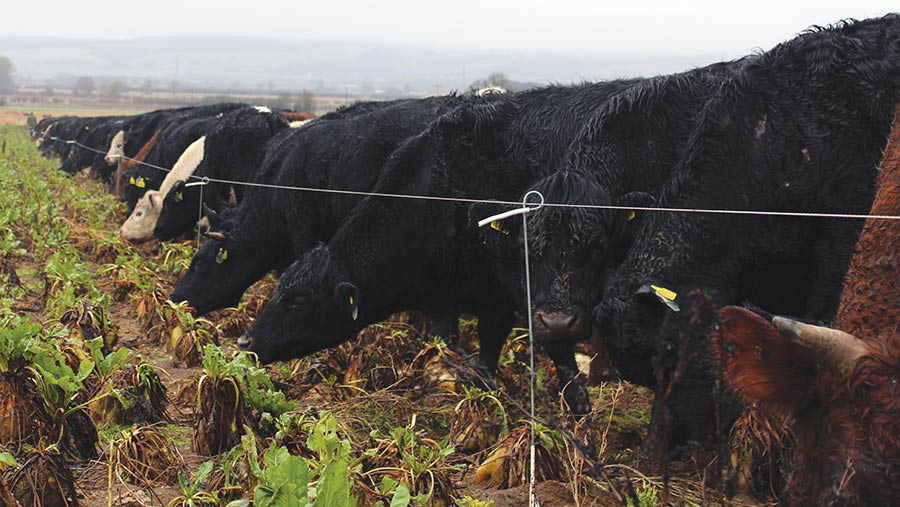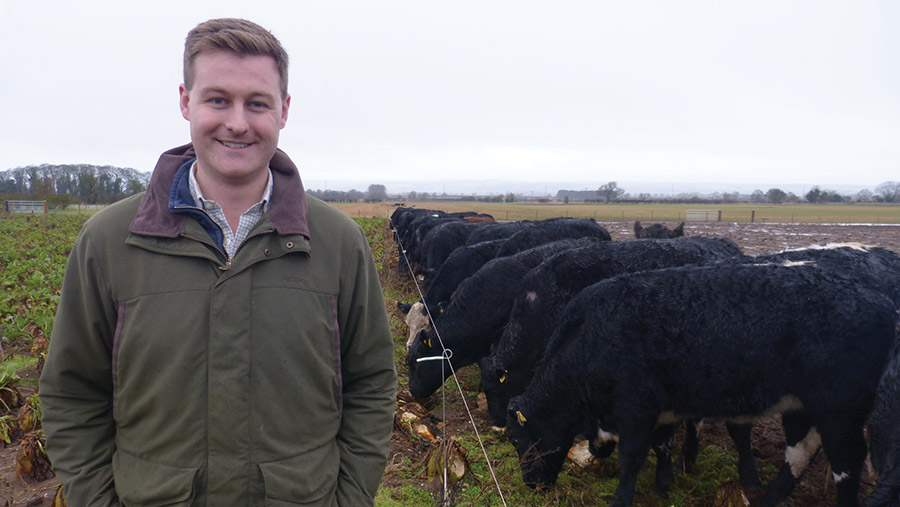How 40.2p/day beet feeding aims for £1,000/ha margin
 © Buitelaar
© Buitelaar A North Yorkshire farming outfit is targeting gross margins of £302.50 a head on its dairy-beef wintering operation based around growing fodder beet for 3.35p/kg of dry matter.
The cattle-on-beet system has replaced inconsistently performing cereal crops on a block of 200ha (494 acres) of sandy land, where it is building soil fertility and organic matter.
The land, bought by Albanwise Wallace Estates, near Pickering, is farmed by the northern half of the 12,000ha (29,652-acre) Albanwise Farming from its base at Low Mowthorpe, Malton.
See also: How to grow better fodder beet – 5 expert tips
Farm facts
Albanwise Farming
- 12,606ha split roughly 50:50 between North Yorkshire and Norfolk
- Arable unit includes milling wheat, malting and feed barley, oilseed rape, spring beans, vining peas, maize and rye
- 200 dairy-cross cattle
- 8,000 bed-and-breakfast pigs
- 405ha of potatoes
- 12,000 store lambs on stubble turnips
- 926ha in environmental schemes
Soil health
Historically, wheat and barley looked great in March but then droughted off, explains Albanwise Farming director Jason Turnbull.
Now, as well as overwintering cattle, the ground, which is 15 minutes from the Low Mowthorpe base, will be let out to carrot growers and will grow potatoes and vining peas.
“Albanwise Farming is effectively a tenant farmer to the holding company, meaning we must be profitable in every enterprise, every year,” explains Jason.
“We aim for £1,000/ha net margin, and growing cereal on that ground does not deliver consistent returns.”
The plan is to use the cattle on the light land to build soil organic matter levels from 2% to nearer 5% as part of a 10-year sustainability plan.
Winter forage system
In 2021, Jason devised a plan to achieve this. During the first winter (2021-22), Albanwise sourced cattle through Meadow Quality.
The kind weather that season allowed them to average more than 1kg of liveweight gain a day and net about £1,400/ha in the first year, but growth rates have been challenged since.
Buitelaar has supplied and marketed the cattle for the past two winters. Albanwise owns the cattle throughout their time on the farm and is paid on a blend of fixed- and spot-price marketing.
The maize that follows the cattle (grown for the farm’s anaerobic digester) receives no fertiliser. It yielded 38t/ha in 2022 and 45t/ha in 2023.
Design
The cattle block is a patchwork of grass and arable ground, so beet can be grown adjacent to large grass fields, helping transition cattle onto beet.
The 200 head of cattle occupy 52ha (128 acres) within the sandy block, of which 17ha (42 acres) is fodder beet in an arable rotation.
The rest of this ground had already been reverted from arable to low-input grassland because it was of archaeological interest. Next winter, beet will be grown and grazed in another area in the block to improve soil health.
Perimeter fencing is being erected each year and mains power extended from the steading to supply electricity to every field, so cattle can be managed on daily moves.
Growing the beet
The fodder beet is grown as follows:
- Variety Geronimo is grown for its tall bulb, which helps cattle pull it out of the ground. Good leaf production provides protein to balance the bulb’s energy.
- Rotation The crop was direct-drilled in April 2023 after vining peas (grown and harvested in July 2022) and stubble turnips (grazed and rented out to a store lamb finisher).
- Establishment Digestate and farmyard manure supplied 150kg/ha of nitrogen (plus phosphate and potassium) prior to direct drilling.
- Inputs A herbicide, two fungicides and a late foliar nitrogen application in September was applied to help the leaf grow bigger and stronger into winter
Transitioning onto beet
A 21-day transition onto beet is vital to avoid acidosis and lost performance, says arable manager Will Jones. He devised the scheme with the help of independent adviser Marc Jones.

Arable manager Will Jones © MAG/Michael Priestley
Working on an average weight of 500kg and 2.2% dry matter (DM) intake, beet is rationed at 12kg DM a head a day (allowing 1kg of wastage) and 2kg of grass, totalling 14kg DM a head a day.
Cattle arrive
Buitelaar supplies the cattle at 350-400kg (averaged 391kg this winter) to be grown, and, ideally, finished. Importantly, they are vaccinated for clostridials so they can graze the forage crop.
This winter, all 200 cattle arrived in two days from 17 October and grazed the low-input grassland on the block.
First beet fed
Lifted fodder beet is crushed with a forklift and fed at grass from arrival to train the cattle. On day five this winter, they opened the gate to the beet field for five hours.
First beet grazed
Initially, just one row of beet is given, supplying 1kg DM a head a day before cattle are returned to grass. Every couple of days, a further 1kg DM a head a day is offered until they are fully transitioned after 21 days.
Main routine
One of the six staff checks the cattle daily. The fence runs 230m across the beet, which is moved 9m daily, leaving a 25% residual.
A second fence runs simultaneously across the adjacent grass field, effectively strip-grazing it.
This winter’s field had three gates put between the grass and the beet to ease cattle flow. Bishopton Vets advised on a mineral bolus and vaccination boosters.
Cattle leave
By about mid-March, Buitelaar draws cattle (if they are finished) or cattle are relocated to finish on grass at Albanwise or elsewhere. They are weighed on and off the farm over a weighbridge.
Weight gain key for £1,000/ha profit
Budgets
Target daily liveweight gains (DLWGs) of 1kg/day add 30,000kg to the herd on a 150-day winter. This equates to £72,000 (£2.40/kg) of income.
Growing the beet cost £11,500 this year, leaving £60,500 to cover fixed costs. This works out at £302.50 a head.
DLWG averaged 0.47kg in 2022-23 and 0.33kg so far in 2023-24. A DLWG of 0.33kg will leave a lower margin after beet growing cost of £235/ha after an extreme year of weather.
(In 2023, the farm had 1,271mm of rainfall; the average is 680mm.)
Variable costs
- Beet Yield in 2022-23 was 20,000t of dry matter (DM)/ha, giving it a cost of £671.12 or 3.35p/kg DM
- Grass The low-input grassland (GS2) could bring in £125/ha and earns £151/ha in Countryside Stewardship. Budgeted at 2kg of grass intake a day, the grassland costs are minimal (so not costed here).
- Daily cost Intake is budgeted at 14kg/day. This has a variable cost of 40.2p/day for 12kg DM of fodder beet (plus 2kg of low-input grass).
Fixed costs
- Labour Checking cattle and moving the fence has been factored in at two hours a day.
- Handling No equipment has been bought yet, instead using the mobile handling facilities of The Flying Farmer contracting company.
- Tractor work Eight tractors share 5,058ha (12,493 acres) of arable work across two North Yorkshire sites. The farm runs three Case Roadtrac 380s and five carting tractors (two Fastracs and three John Deeres) and four loadalls.
